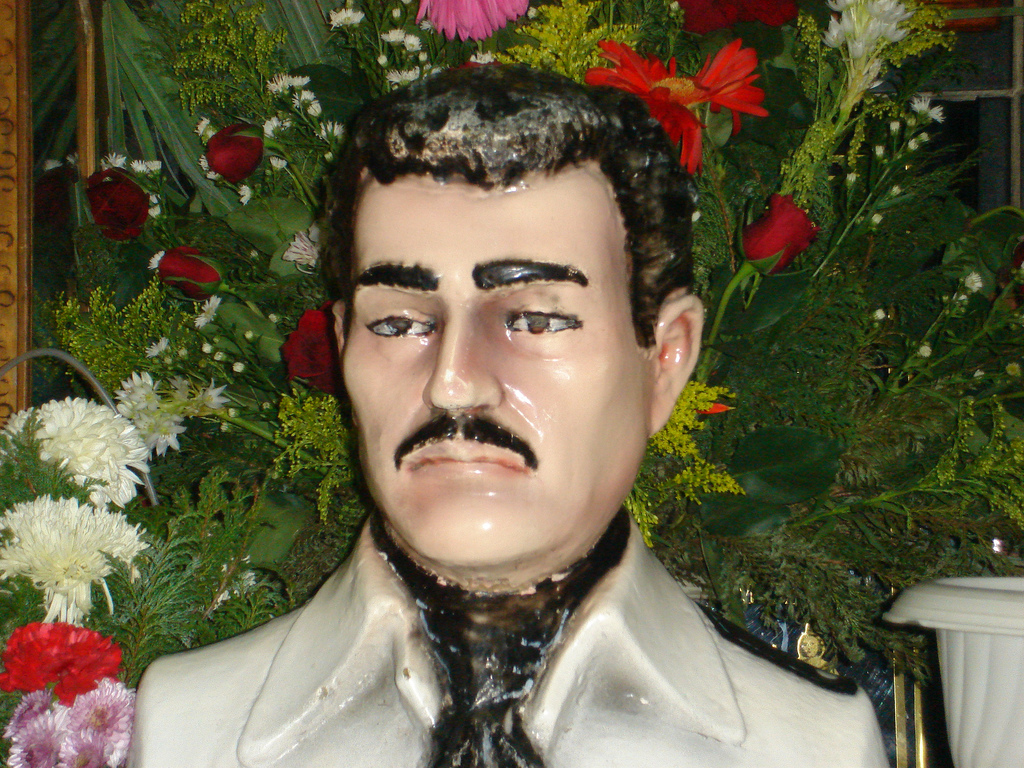Mexico Unexplained: Jesus Malverde, the Mexican Robin Hood
He is known by several nicknames: Mexico’s Robin Hood, The Generous Bandit, The Angel of the Poor, The Drug Saint and The King of Sinaloa, but was Jesus Malverde even real? And to whether or not he was real, does it matter? He has a following of hundreds of thousands of people in Mexico and the United States, mostly the dispossessed and the downtrodden, and to them he is very real. Who was this man?

There is very little in the historical record to support Jesus Malverde as a real historical figure. The legend is supposedly based on a man named Jesus Juárez Mazo, who was from a small town outside the city of, the capital of the great state of Sinaloa on the Pacific coast of Mexico. Mazo was born on December 24, 1870 and died on May 3, 1909, killed by the authorities for his banditry. He grew up extremely poor during a time of huge disparities in income in Mexico, and especially in Sinaloa. This was the age of the Porfiriato, the reign of the Mexican dictator Porfirio Díaz, and Sinaloa was ruled by an elite class of wealthy hacienda owners, known as hacendados in Spanish. Mazo’s parents either died of a curable disease or because they were just poor, according to legend, and instead of struggling to earn a living with his menial labor jobs, the man later known as Malverde turned to a life of robbing from the rich. He is called El Bandido Generoso, the Generous Bandit, because he gave away most of what he stole from the wealthy hacendados.
In one of the more popular versions of the story, the wealthy governor of Sinaloa, Francisco Cañedo, challenged Jesus Malverde to steal the governor’s sword out of his hacienda, and promised to grant him a pardon if he was successful. Malverde slipped in and out of the governor’s home and left a note in place of the sword. Incensed, the governor went back on his word and had the police hunt down Malverde to face justice.
According to popular lore, Jesus Malverde met his demise through hanging. He was executed outside the courthouse in Culiacán and was denied a proper burial. He was just left to hang on the makeshift gallows the governor had set up. When his body fell to the ground, people placed stones and pebbles on top of it, in the sort of a fashion of a cairn, to give their popular bandit a more proper burial. Later, a shrine popped up on the spot. An alternate ending to the Jesus Malverde story has him shot by firing squad and left to lie in the dirt. A woman then ran up to his body and dug up some of the dirt that was soaked in his blood. Later that blood-soaked dirt was put into small bottles and shrines throughout northern Mexico grew up around the veneration of these relics.
As previously mentioned, there is little evidence that Jesus Malverde was even real. The dates and incidents of his life loosely coincide with the life of Jesus Juárez Mazo, but there is no confirmation that Mazo ever gave back to the poor or that he had the famous run-in with the Sinaloan governor. Researchers claim that the Jesus Malverde persona is based on an amalgamation of two other bandits from the state of Sinaloa popular around the same time. They were named Heraclio Bernal and Felipe Bachomo. These two were seen as heroes of their time because of their disdain for authority and for their elusiveness. The death of a real man, Mazo, though, seemed to be the starting point of the development of Jesus Malverde as a folk saint.
In the various versions of the legend, a shrine to Malverde sprang up near the courthouse where he was supposedly killed. For most of the 20th Century, this man was seen as a miracle worker of the common person, the poor and the otherwise marginalized. Jesus Malverde was a victim of society’s injustices while he was alive, so as a poor person who is also a victim, he will listen to you. He will hear your prayers and deliver miracles to you. People have sought out his help mostly with issues regarding finances, employment, incarceration and other run-ins with the law and business problems. The devotee can petition Jesus Malverde for help, much like one would ask for a miracle from any Catholic saint. The only difference here is that if the devotee fails to uphold his or her end of the bargain, the petition for a miracle will turn into a curse.
What does the Catholic Church think of all of this? Simply put, it doesn’t recognize him even though the common people treat Jesus Malverde as they would a Catholic saint on par with Saint Jude or even the Virgin of Guadalupe. He even has a feast day, May 3rd, the day he was supposedly executed by the authorities. There are shrines all over northern Mexico to Jesus Malverde and people go to them as they would any other saint. In his 2012 visit to Mexico, Pope Benedict XVI admonished followers of folk saints like Jesus Malverde likening the phenomenon to a cult. Even with the pope coming to Mexico and shaking his finger at wayward parishioners, the adoration of Jesus Malverde has increased over time and sees no sign of stopping.

Long before the pope’s visit, the popularity of this saint got a huge boost from the illegal drug trade. In the 1980s and 1990s the various cartels appropriated the Jesus Malverde phenomenon as part of a calculated PR strategy. See, Malverde was like them, fighting against authority and giving back to the community with their illicit earnings, building hospitals, schools and roads in poor and rural communities and providing employment when the government refused to help. The drug traffickers used their supposed devotion to this folk saint to also show that they, too, are common people, just like you and me. Many Jesus Malverde shrines throughout Mexico have been built by the narcotraficantes themselves. The mustachioed image of Jesus Malverde is associated with the drug trade more on the American side of the border than on the Mexican side.
The modern shrine to Jesus Malverde in Culiacán is across the train tracks from the original shrine that sprouted up right after the bandit’s supposed 1909 death. The original shrine was demolished in the 1970s to make a parking lot to accommodate the ever expanding government buildings surrounding the original courthouse. No one wanted to be the one to do the actual demolition of the shrine and according to accounts at the time the bulldozer operator was drunk while doing the demo so as to ease the pain of the thoughts of the sin he was committing. Eyewitnesses claim that when the bulldozer got to the cairn that covered the body of Jesus Malverde that the rocks were jumping out like popcorn popping out of a fire. Alas, no film footage exists.
The new shrine is modern and has a main altar with a bust of the saint and ample room for adequate veneration. People come from all over Mexico to make this pilgrimage to ask Jesus Malverde for help. Alms are collected for local charities, and those articles left behind in thanks are given away to the poor. Every May 2nd there is a lively celebration at the shrine in the evening and in the morning of May 3rd - the day of Malverde’s supposed execution - the main bust of the saint is taken out of the shrine, cleaned, and paraded around the neighborhood. Vendors sell food and the atmosphere is very festive, much like any Mexican fiesta to celebrate a saint, except the statue doesn’t end up at a church and there is no mass. To those people who celebrate him and believe in him, there is no doubt that Jesus Malverde is the real deal.
So what do we make of the miracles ascribed to this folk saint? Are we seeing the power of focused intention in action? Is it mass psychosis? Wishful thinking? The questions are left to the researchers and the faithful.